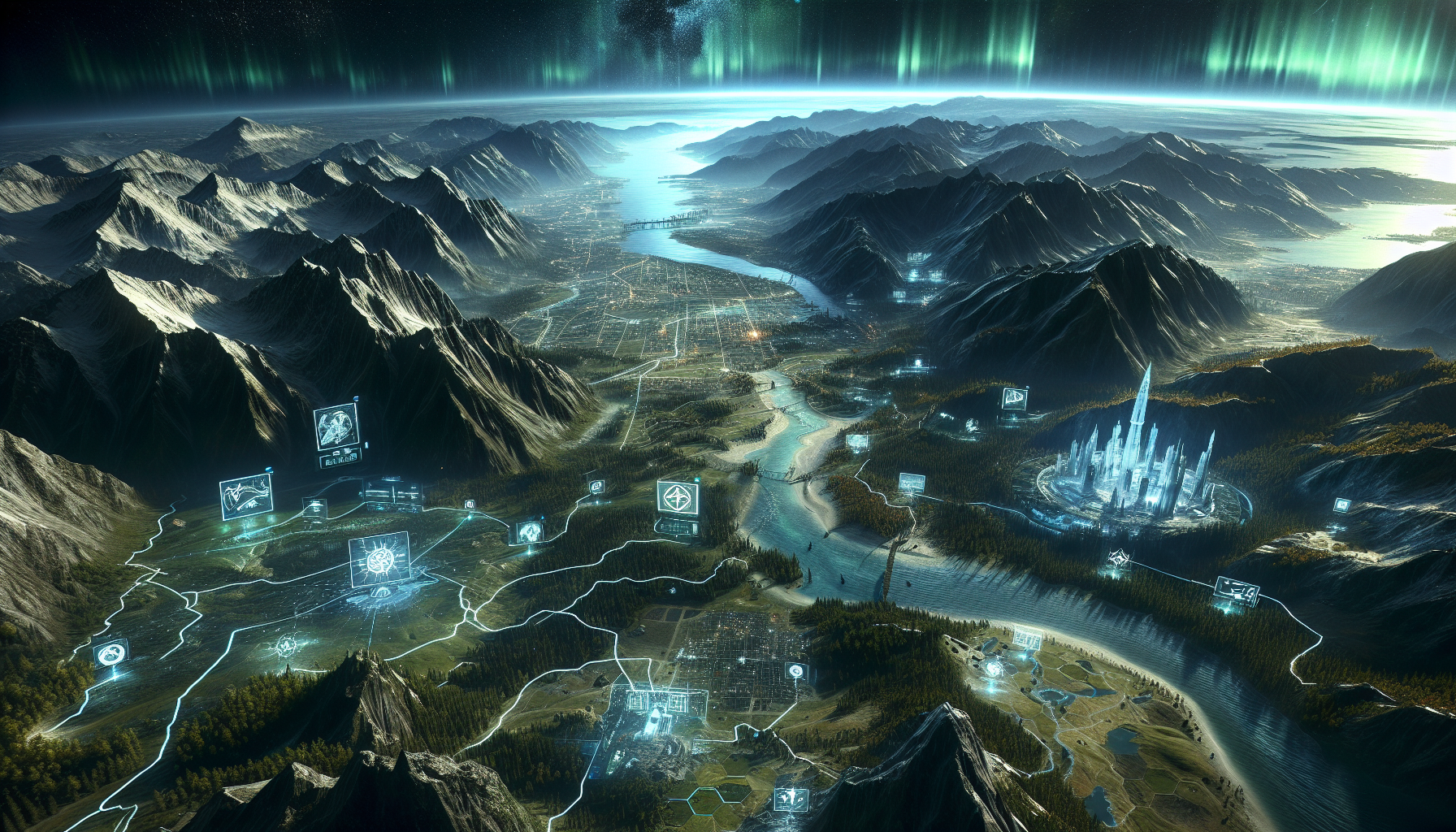In the ever-evolving landscape of digital connectivity, understanding and optimizing Wi-Fi networks is more crucial than ever. With the rapid proliferation of smart devices, the demand for seamless and efficient internet access continues to rise. This post delves into the innovative realm of heatmaps and digital cartography, tools that are revolutionizing how we visualize and enhance Wi-Fi coverage in both residential and commercial spaces.
Imagine being able to visualize the invisible waves of your Wi-Fi network, pinpointing areas of strength and weakness with precision. Heatmaps offer this unique insight, enabling users to map the coverage and performance of their networks. By leveraging these maps, one can identify dead zones, optimize router placement, and even anticipate the impact of physical obstructions on signal strength.
The integration of digital cartography takes this concept a step further, providing a comprehensive view of network topography. This advanced approach not only visualizes current Wi-Fi coverage but also allows for predictive modeling and simulation. Whether you’re setting up a new network or fine-tuning an existing one, digital cartography equips you with the tools to make informed decisions, ensuring robust connectivity throughout your space.
Moreover, these technologies aren’t just for tech enthusiasts or IT professionals. They offer valuable insights for homeowners seeking to maximize their internet experience, businesses aiming to improve customer satisfaction, and developers looking to integrate smarter infrastructure solutions. With user-friendly interfaces and accessible data, heatmaps and digital cartography democratize network optimization, making it accessible to everyone.
The Evolution of Wi-Fi Heatmaps
Wi-Fi heatmaps have become an essential tool in understanding and optimizing wireless networks. Traditionally, these maps were rudimentary, offering basic insights into signal strength within a given area. Today, however, they have evolved significantly, integrating advanced technology to provide more detailed and actionable data. Heatmaps now not only illustrate signal strength but also identify potential interference sources and suggest solutions for enhancing network performance.
One of the most significant advancements in heatmap technology is the incorporation of real-time data collection. This allows for a dynamic representation of network conditions, giving users the ability to monitor changes as they happen. With this capability, network administrators can respond swiftly to connectivity issues, ensuring minimal downtime and a seamless user experience. Moreover, the use of machine learning algorithms has enabled these tools to predict potential issues before they occur, offering preemptive solutions and improving overall network reliability.
Understanding Digital Cartography in Wi-Fi Mapping
Digital cartography has revolutionized the way we approach Wi-Fi mapping. Unlike traditional cartography, which focuses on geographical features, digital maps prioritize data representation and user interaction. This shift has profound implications for Wi-Fi optimization, as it allows for a more nuanced understanding of network environments.
In the realm of Wi-Fi, digital cartography offers the ability to layer various data sets over a single map. This multi-layer approach provides a holistic view of network conditions, including signal strength, user density, and potential interference sources. By integrating these layers, users can identify patterns and correlations that might not be apparent through a singular data set, facilitating more informed decision-making.
Key Components of a Digital Wi-Fi Map
Creating an effective digital Wi-Fi map involves several key components. First, accurate data collection is crucial. This requires the use of advanced sensors and software capable of capturing real-time network conditions. Next, data visualization tools transform raw data into comprehensible maps, using color codes and symbols to represent different network parameters.
Another critical component is the user interface. A well-designed interface allows users to navigate complex data easily, providing intuitive controls for adjusting map parameters and viewing different data layers. Additionally, the ability to export and share maps enhances collaboration, allowing multiple stakeholders to contribute to network optimization efforts.
Leveraging Heatmaps for Wi-Fi Optimization
Utilizing heatmaps effectively can lead to significant improvements in Wi-Fi performance. By pinpointing areas with weak signals or high interference, users can make targeted adjustments to access point placement, channel settings, and power levels. This targeted approach ensures that resources are allocated efficiently, enhancing network coverage and speed without unnecessary expenditure.
Heatmaps also play a crucial role in identifying unauthorized network access. By monitoring device activity and location, network administrators can detect suspicious behavior and take appropriate measures to secure the network. This proactive approach to security helps protect sensitive data and maintain user trust.
Steps to Create a Wi-Fi Heatmap
- Survey the Area: Conduct a thorough assessment of the physical space, noting potential obstacles and sources of interference.
- Gather Data: Use specialized software to collect real-time data on signal strength and network traffic.
- Analyze Results: Interpret the heatmap to identify areas of weak coverage and potential interference.
- Implement Solutions: Adjust access points, channel settings, and other parameters to optimize network performance.
Case Studies: Success Stories of Heatmap Implementation
Many organizations have successfully harnessed the power of Wi-Fi heatmaps to enhance their network capabilities. For instance, a large university implemented heatmap technology to address connectivity issues in its dormitories. By analyzing the heatmaps, they identified areas of poor coverage and strategically placed additional access points to ensure consistent, high-speed internet access for students.
Similarly, a healthcare facility used heatmaps to improve its network’s resilience against interference from medical equipment. By identifying interference patterns, they were able to reconfigure their network to avoid frequency overlaps, ensuring reliable connectivity for critical devices and improving patient care.
Table: Key Benefits of Using Wi-Fi Heatmaps
| Benefit | Description |
|---|---|
| Enhanced Coverage | Identifies areas of weak signal, allowing for targeted improvements. |
| Increased Security | Monitors device activity to detect unauthorized access. |
| Cost Efficiency | Optimizes resource allocation, reducing unnecessary expenditure. |
The Future of Wi-Fi Heatmaps and Digital Cartography
Looking forward, the integration of artificial intelligence and machine learning is poised to further enhance the capabilities of Wi-Fi heatmaps and digital cartography. These technologies promise to deliver even more precise predictions and optimizations, transforming the way we interact with our wireless environments.
As these tools continue to evolve, we can expect to see their application extend beyond traditional network management. Emerging fields such as smart cities and the Internet of Things (IoT) stand to benefit significantly from advanced mapping techniques, paving the way for innovative solutions and smarter, more connected communities.

結論
In conclusion, the advancement of Wi-Fi heatmaps and digital cartography marks a significant leap in the optimization and management of wireless networks. These innovative tools have evolved from simple signal strength indicators to sophisticated systems that incorporate real-time data and machine learning. Consequently, they offer a dynamic and interactive approach to enhancing network performance. By integrating digital cartography with Wi-Fi heatmaps, users gain a multi-dimensional perspective of their network environments, allowing for precise adjustments and informed decision-making. Moreover, these tools are essential in identifying and addressing potential security risks, ensuring a safe and reliable network experience.
Furthermore, the benefits extend beyond immediate network improvements. As heatmaps and digital cartography continue to integrate artificial intelligence, their predictive capabilities will only grow, enabling preemptive solutions that enhance network resilience. This progression not only optimizes current systems but also sets the stage for future innovations in smart cities and IoT applications. Ultimately, leveraging these technologies leads to more efficient resource allocation, reduced operational costs, and improved user satisfaction. As we navigate the complexities of our wireless world, embracing the power of heatmaps and digital cartography ensures a seamless, secure, and interconnected future. 📶✨
托尼·桑托斯 是一位數位製圖師、視覺思考者和奇妙事物的策展人。在 艾薩克,他潛入了 奇異的地圖、想像的地理環境以及另類的製圖現實,為我們如何看待和感受周圍的世界提供了新的視角。
他的工作根植於這樣的信念: 地圖不僅僅是導航工具。它們是通往感知、記憶、想像甚至神話的門戶。從扭曲的歷史圖表到超現實的地形、陰謀地圖集和人工智慧生成的世界構建, Toni 製作並收集挑戰邏輯並激發好奇心的地圖.
Toni 擁有講故事、藝術和象徵探索的背景,她利用 Aysapp 作為平台來揭示 被遺忘的地方、無形的邊界和重新想像的現實。他的作品提出了這樣的問題:如果世界顛倒了會怎麼樣?如果地圖講述的是情感真相而非地理真相,那會怎麼樣?
作為幕後的創造者 艾薩克,他的使命是 激發好奇心,鼓勵創造性思維,並探索想像力、文化和空間敘事之間的交集——一次一張奇怪的地圖。
🌀 他的地圖宇宙探索:
-
不真實卻有意義的風景
-
情感、記憶與神話作為地理
-
扭曲地圖以揭示隱藏的真相
無論您是幻想世界的愛好者、地圖收藏家、好奇的旅行者,還是喜歡不尋常事物的人, 東尼邀請您——有意地——迷失在製圖想像中最非凡的角落。




